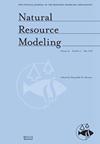干旱半干旱地区雨水资源利用评价模型及其影响因素
IF 1.8
4区 环境科学与生态学
Q3 ENVIRONMENTAL SCIENCES
引用次数: 0
摘要
干旱和半干旱地区普遍面临自然资源退化的问题。本文提出了两个表征雨水利用的指标:雨水资源利用量(RRU,mm)和雨水资源利用率(RRUR,无量纲比值)。建立了RRUR及其影响因素的时空评价模型(雨水利用评价[RUA]模型)。RUA模型基于土壤和水资源评估工具和地理时间加权回归。祖里河流域位于中国黄土高原,被选为研究流域。结果表明,RRU和RRUR的年平均值为164 mm和0.44。RRU在71.4到243.2之间 mm,并且在评估期间RRUR在0.32到0.53之间。选取了8个解释变量,其中叶面积指数(LAI)和降雨量对RRUR有显著的正向影响,但影响存在时空变异性。能够提高LAI的森林恢复和轮作可以有效地提高RRUR,RRUR分别增加了0.10和0.11,RRU至少增加了36.42 mm,水量3.85 × 108 m3。草原恢复和平行梯田对RRUR的影响较小。研究发现,流域内降水利用存在区间效应和阈值效应。间隔效应导致RRUR在300–400或400–500的降雨间隔的特定范围内波动 mm(祖里河流域)。阈值效应可以指导确定不同地区的雨水利用潜力,以确保通过管理措施有效提高RRUR。本文章由计算机程序翻译,如有差异,请以英文原文为准。
Assessment model of rainwater resource utilization and influencing factors in arid and semiarid areas
Arid and semiarid areas generally face problems of natural resource degradation. In this paper, two indicators are proposed to characterize the utilization of rainwater: rainwater resource utilization quantity (RRU, mm) and rainwater resource utilization rate (RRUR, dimensionless ratio). A spatiotemporal assessment model (rainwater utilization assessment [RUA] model) for the RRUR and its influencing factors is constructed. The RUA model is based on Soil and Water Assessment Tool and Geographically Temporal Weighted Regression. The Zuli River Basin, located on the Loess Plateau in China, was selected as the study basin. The results show that the annual averages of the RRU and RRUR are 164 mm and 0.44, respectively, in the study basin. The RRU ranged from 71.4 to 243.2 mm, and the RRUR ranged from 0.32 to 0.53 during the evaluation period. Eight explanatory variables were selected, of which the leaf area index (LAI) and rainfall had a significant positive effect on RRUR, but there was spatial and temporal variability in the effects. The forest rehabilitation and crop rotations that can increase the LAI can effectively increase the RRUR, which increased by 0.10 and 0.11, respectively, and the increase in RRU was at least 36.42 mm, with a water volume of 3.85 × 108 m3. The impact of grassland rehabilitation and parallel terracing on the RRUR was small. We found that there is an interval effect and a threshold effect on rainfall utilization in the basin. The interval effect causes the RRUR to fluctuate within a certain range for rainfall intervals of 300–400 or 400–500 mm (Zuli River Basin). Threshold effects can guide the determination of the potential for rainwater utilization in different areas to ensure that the RRUR can be effectively enhanced with management measures.
求助全文
通过发布文献求助,成功后即可免费获取论文全文。
去求助
来源期刊

Natural Resource Modeling
环境科学-环境科学
CiteScore
3.50
自引率
6.20%
发文量
28
审稿时长
>36 weeks
期刊介绍:
Natural Resource Modeling is an international journal devoted to mathematical modeling of natural resource systems. It reflects the conceptual and methodological core that is common to model building throughout disciplines including such fields as forestry, fisheries, economics and ecology. This core draws upon the analytical and methodological apparatus of mathematics, statistics, and scientific computing.
 求助内容:
求助内容: 应助结果提醒方式:
应助结果提醒方式:


